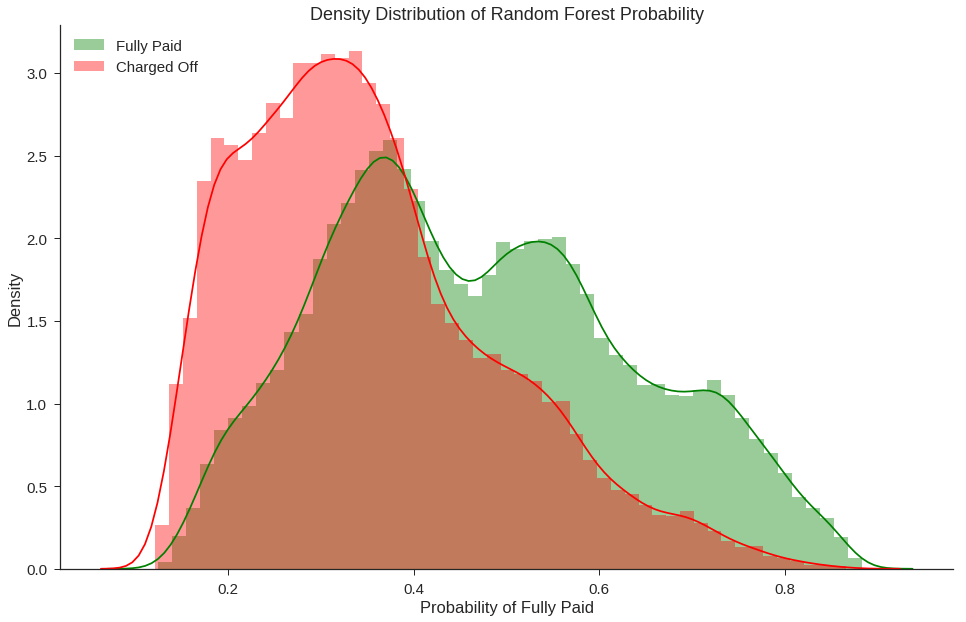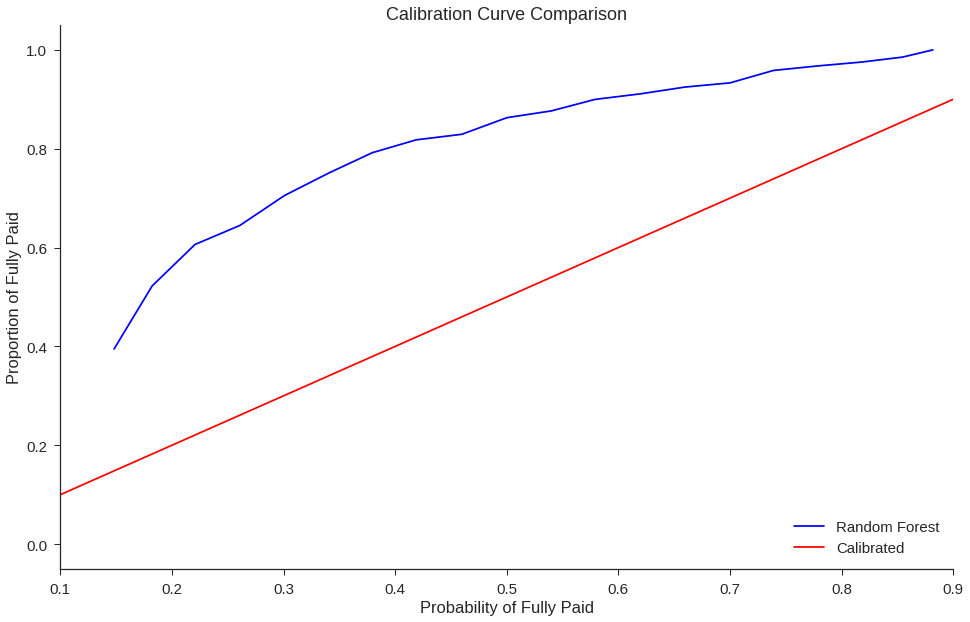Fairness - Bias Detection and Mitigation
Linking the US census data with the Lending Club loan data to assign racial proportions to zip codes, we can utilize IBMAIF360, The AI Fairness 360 toolkit, which is an open-source library to help detect and remove bias in machine learning models. We specifically look at how Caucasians fair on average, compared to other racial groups in terms of loan outcomes (fully paid or charged off). It is worth noting that we are not able to directly compare Caucasion borrowers with minority borrowers because we do not have the information on borrower’s race. Instead, we use the 3-digit zip-code provided in the loan data to determine whether or not the borrower comes from an area with relatively large portions of minorities by population. We have assigned these borrowers to the “underprivileged” group.
After discovering a disparity between underprivileged and privileged groups in the outcomes, we can then reweigh the data in order to eliminate the inherent bias before feeding it into our models.
import requests
#from IPython.core.display import HTML
#styles = requests.get("https://raw.githubusercontent.com/Harvard-IACS/2018-CS109A/master/content/styles/cs109.css").text
#HTML(styles)
from IPython.display import clear_output
from datetime import datetime
%matplotlib inline
import numpy as np
import pandas as pd
import matplotlib
import matplotlib.pyplot as plt
import seaborn as sns
sns.set(font_scale=1.5)
sns.set_style('ticks')
from os import listdir
from os.path import isfile, join
from sklearn.model_selection import train_test_split
from sklearn.model_selection import cross_val_score
from sklearn.metrics import accuracy_score
from sklearn.tree import DecisionTreeClassifier
import os
#Google Collab Only"
from google.colab import drive
drive.mount('/content/gdrive', force_remount=True)
#os.listdir('/content/gdrive/My Drive/Lending Club Project/data')
#!pip install aif360
import sys
sys.path.append("../")
from aif360.metrics import BinaryLabelDatasetMetric
from aif360.metrics import DatasetMetric
from aif360.metrics import ClassificationMetric
from aif360.datasets import StandardDataset
from aif360.datasets import BinaryLabelDataset
from aif360.algorithms.preprocessing.optim_preproc import OptimPreproc
from aif360.algorithms.preprocessing.reweighing import Reweighing
from IPython.display import Markdown, display
from sklearn.linear_model import LogisticRegression
from sklearn.metrics import precision_score
from sklearn.ensemble import RandomForestClassifier
Combining the cleaned up with the US census data by linking the zip_code column.
#loan_df= pd.read_pickle('clean_df.pkl')
path = '/content/gdrive/My Drive/Lending Club Project/data/Pickle/'
filename = 'clean_df_Mon.pkl'
loan_df= pd.read_pickle(path+filename)
path = '/content/gdrive/My Drive/Lending Club Project/data/census/'
filename = 'census_zipcode_level.csv'
print(os.listdir(path))
census_data= pd.read_csv(path+filename)
#census_data = pd.read_csv('census_zipcode_level.csv')
census_data['zip_code_3dig'] = census_data['Zip'].apply(lambda x: (str(x))[:3])
#new df aggregated based on 3-digit zip code
zip3_df = census_data.groupby('zip_code_3dig').agg({'Population':np.sum, 'White':np.sum})
zip3_df['percent_white'] = zip3_df['White']/zip3_df['Population']
display(zip3_df.head())
cutoff = zip3_df.percent_white.quantile(0.05) # about ## white
zip3_df['underprivileged'] = zip3_df.percent_white.apply(lambda x: x<=cutoff).astype(int)
underprivileged_zips = np.array(zip3_df[zip3_df.underprivileged==1].index)
['.DS_Store', 'census_zipcode_level.csv']
| Population | White | percent_white | |
|---|---|---|---|
| zip_code_3dig | |||
| 100 | 1626010 | 778151 | 0.478565 |
| 101 | 92971 | 66973 | 0.720364 |
| 102 | 84350 | 68024 | 0.806449 |
| 103 | 510347 | 330622 | 0.647838 |
| 104 | 1479033 | 155696 | 0.105269 |
Assigning the underprivileged class as 1 and the privileged as 0 allows us to perform a two-class classification that places members of the cacusian race as privileged and members of other racial groups as 1. This allow us to perform a two class classification on one sensitive attribute.
This is a pre-processing step to mitigate any inherent bias that may be present in our dataset and mitigating it, before feeding it into our classifier.
loan_df['underprivileged'] = loan_df.zip_code.apply(lambda x: x in (underprivileged_zips)).astype(int)
loan_df.underprivileged.value_counts() #underprivileged = 1
0 960120
1 127316
Name: underprivileged, dtype: int64
outcome_column='fully_paid'
data_train, data_test = train_test_split(loan_df, test_size = 0.1, shuffle = True, stratify = loan_df[outcome_column], random_state =99)
print(data_train.shape, data_test.shape)
X_train = data_train.drop(columns=[outcome_column,'credit_line_age','issue_d','addr_state','zip_code'])
y_train = data_train[outcome_column]
X_test = data_test.drop(columns=[outcome_column,'credit_line_age','issue_d','addr_state','zip_code'])
y_test = data_test[outcome_column]
data_train, data_val = train_test_split(data_train, test_size=.2, stratify=data_train[outcome_column], random_state=99)
print(data_train.shape, data_val.shape)
(978692, 88) (108744, 88)
(782953, 88) (195739, 88)
importances = ['int_rate', 'sub_grade', 'dti', 'installment', 'avg_cur_bal', 'mo_sin_old_rev_tl_op', 'bc_open_to_buy', 'credit_line_age', 'tot_hi_cred_lim', 'annual_inc', 'revol_util', 'bc_util', 'mo_sin_old_il_acct', 'revol_bal', 'total_rev_hi_lim', 'total_bc_limit', 'tot_cur_bal', 'total_bal_ex_mort', 'loan_amnt', 'total_il_high_credit_limit', 'mths_since_recent_bc', 'total_acc', 'mo_sin_rcnt_rev_tl_op', 'num_rev_accts', 'num_il_tl', 'grade', 'mths_since_recent_inq', 'mo_sin_rcnt_tl', 'num_bc_tl', 'acc_open_past_24mths', 'open_acc', 'num_sats', 'pct_tl_nvr_dlq', 'num_op_rev_tl', 'mths_since_last_delinq', 'percent_bc_gt_75', 'term_ 60 months', 'num_actv_rev_tl', 'num_rev_tl_bal_gt_0', 'num_bc_sats', 'num_actv_bc_tl', 'num_tl_op_past_12m', 'mths_since_recent_revol_delinq', 'mort_acc', 'mths_since_last_major_derog', 'mths_since_recent_bc_dlq', 'tot_coll_amt', 'mths_since_last_record', 'inq_last_6mths', 'num_accts_ever_120_pd', 'delinq_2yrs', 'pub_rec', 'verification_status_Verified', 'verification_status_Source Verified', 'emp_length_10+ years', 'purpose_debt_consolidation', 'emp_length_5-9 years', 'emp_length_2-4 years', 'home_ownership_RENT', 'purpose_credit_card', 'pub_rec_bankruptcies', 'home_ownership_MORTGAGE', 'home_ownership_OWN', 'num_tl_90g_dpd_24m', 'tax_liens', 'purpose_other', 'purpose_home_improvement', 'collections_12_mths_ex_med', 'purpose_major_purchase', 'purpose_small_business', 'purpose_medical', 'application_type_Joint App', 'purpose_moving', 'chargeoff_within_12_mths', 'purpose_vacation', 'delinq_amnt', 'purpose_house', 'acc_now_delinq', 'purpose_renewable_energy', 'purpose_wedding', 'home_ownership_OTHER', 'home_ownership_NONE', 'purpose_educational']
Using a Logistic Regression model with balanced class weight to use the values of y to automatically adjust weights inversely proportional to class frequencies in the input data. And then fitting it onto X_train and y_train.
lrm = LogisticRegression(class_weight='balanced').fit(X_train, y_train)
** A wraper function to create aif360 dataset from outcome and protected in numpy array format.**
def dataset_wrapper(outcome, protected, unprivileged_groups, privileged_groups,
favorable_label, unfavorable_label):
df = pd.DataFrame(data=outcome,
columns=[outcome_column])
df['underprivileged'] = protected
dataset = BinaryLabelDataset(favorable_label=favorable_label,
unfavorable_label=unfavorable_label,
df=df,
label_names=[outcome_column],
protected_attribute_names=['underprivileged'],
unprivileged_protected_attributes=unprivileged_groups)
return dataset
u = [{'underprivileged': 1.0}]
p = [{'underprivileged': 0.0}]
favorable_label = 1.0
unfavorable_label = 0.0
protected_train = data_train['underprivileged']
protected_test = data_test['underprivileged']
We create a new dataset from the prediction on X_test. This way everything except the labels is copied from the ground-truth test set.
y_pred2=pd.DataFrame(y_test)
y_pred2['predictions']=lrm.predict(X_test)
y_pred2=y_pred2.drop([outcome_column], axis=1).rename(columns={'predictions': outcome_column})
#y_train
original_training_dataset = dataset_wrapper(outcome=y_train, protected=protected_train,
unprivileged_groups=u,
privileged_groups=p,
favorable_label=favorable_label,
unfavorable_label=unfavorable_label)
#y_test
original_test_dataset = dataset_wrapper(outcome=y_test, protected=protected_test,
unprivileged_groups=u,
privileged_groups=p,
favorable_label=favorable_label,
unfavorable_label=unfavorable_label)
#test_predictions
plain_predictions_test_dataset = dataset_wrapper(outcome=y_pred2, protected=protected_test,
unprivileged_groups=u,
privileged_groups=p,
favorable_label=favorable_label,
unfavorable_label=unfavorable_label)
Fairness: Test vs Predictions
classified_metric_nodebiasing_test = ClassificationMetric(original_test_dataset,
plain_predictions_test_dataset,
unprivileged_groups=u,
privileged_groups=p)
display(Markdown("#### Plain model - without debiasing - classification metrics"))
print("Test set: Classification accuracy = %f" % classified_metric_nodebiasing_test.accuracy())
#print("Test set: Balanced classification accuracy = %f" % bal_acc_nodebiasing_test)
print("Test set: Statistical parity difference = %f" % classified_metric_nodebiasing_test.statistical_parity_difference())
print("Test set: Disparate impact = %f" % classified_metric_nodebiasing_test.disparate_impact())
print("Test set: Equal opportunity difference = %f" % classified_metric_nodebiasing_test.equal_opportunity_difference())
print("Test set: Average odds difference = %f" % classified_metric_nodebiasing_test.average_odds_difference())
print("Test set: Theil index = %f" % classified_metric_nodebiasing_test.theil_index())
print("Test set: False negative rate difference = %f" % classified_metric_nodebiasing_test.false_negative_rate_difference())
Plain model - without debiasing - classification metrics
Test set: Classification accuracy = 0.652441
Test set: Statistical parity difference = -0.019635
Test set: Disparate impact = 0.966937
Test set: Equal opportunity difference = -0.013784
Test set: Average odds difference = -0.013502
Test set: Theil index = 0.354349
Test set: False negative rate difference = 0.013784
Reweigh via tranformation for Training
RW = Reweighing(unprivileged_groups=u,
privileged_groups=p)
RW.fit(original_training_dataset)
transf_training_dataset = RW.transform(original_training_dataset)
metric_orig_train = BinaryLabelDatasetMetric(original_training_dataset,
unprivileged_groups=u,
privileged_groups=p)
metric_tranf_train = BinaryLabelDatasetMetric(transf_training_dataset,
unprivileged_groups=u,
privileged_groups=p)
display(("Original training dataset"))
print("Difference in mean outcomes between privileged and unprivileged groups = %f" % metric_orig_train.mean_difference())
display(("Transformed training dataset"))
print("Difference in mean outcomes between privileged and unprivileged groups = %f" % metric_tranf_train.mean_difference())
'Original training dataset'
Difference in mean outcomes between privileged and unprivileged groups = -0.017565
'Transformed training dataset'
Difference in mean outcomes between privileged and unprivileged groups = 0.000000
Reweight via transformation for test
metric_orig_test = BinaryLabelDatasetMetric(original_test_dataset,
unprivileged_groups=u,
privileged_groups=p)
transf_test_dataset = RW.transform(original_test_dataset)
metric_transf_test = BinaryLabelDatasetMetric(transf_test_dataset,
unprivileged_groups=u,
privileged_groups=p)
display(("Original testing dataset"))
print("Difference in mean outcomes between privileged and unprivileged groups = %f" % metric_orig_test.mean_difference())
display(("Transformed testing dataset"))
print("Difference in mean outcomes between privileged and unprivileged groups = %f" % metric_transf_test.mean_difference())
'Original testing dataset'
Difference in mean outcomes between privileged and unprivileged groups = -0.019698
'Transformed testing dataset'
Difference in mean outcomes between privileged and unprivileged groups = -0.002036
Using the instance weights from the transformed training dataset we fit our final model, a Random Forest Classifier.
features = importances[0:43]
depth = 8
weight = 6
rf_model = RandomForestClassifier(n_estimators=500, max_depth=depth, class_weight={0:weight, 1:1})
rf_model.fit(X_train, y_train, sample_weight = transf_training_dataset.instance_weights)
RandomForestClassifier(bootstrap=True, class_weight={0: 6, 1: 1},
criterion='gini', max_depth=8, max_features='auto',
max_leaf_nodes=None, min_impurity_decrease=0.0,
min_impurity_split=None, min_samples_leaf=1,
min_samples_split=2, min_weight_fraction_leaf=0.0,
n_estimators=500, n_jobs=None, oob_score=False,
random_state=None, verbose=0, warm_start=False)
y_pred_test = rf_model.predict(X_test)
precision_score(y_test, y_pred_test)
0.9132855609098399
rf_model.score(X_test, y_test)
0.5066946222320312
data_test['RF_Model_Prediction'] = rf_model.predict(X_test)
data_test['RF_Probability_Fully_Paid'] = rf_model.predict_proba(X_test)[:,1]
/usr/local/lib/python3.6/dist-packages/ipykernel_launcher.py:1: SettingWithCopyWarning:
A value is trying to be set on a copy of a slice from a DataFrame.
Try using .loc[row_indexer,col_indexer] = value instead
See the caveats in the documentation: http://pandas.pydata.org/pandas-docs/stable/indexing.html#indexing-view-versus-copy
"""Entry point for launching an IPython kernel.
/usr/local/lib/python3.6/dist-packages/ipykernel_launcher.py:2: SettingWithCopyWarning:
A value is trying to be set on a copy of a slice from a DataFrame.
Try using .loc[row_indexer,col_indexer] = value instead
See the caveats in the documentation: http://pandas.pydata.org/pandas-docs/stable/indexing.html#indexing-view-versus-copy
fig, ax = plt.subplots(figsize=(16,10))
sns.distplot(data_test[data_test['fully_paid']==1]['RF_Probability_Fully_Paid'],color='green',rug=False,label='Fully Paid')
sns.distplot(data_test[data_test['fully_paid']==0]['RF_Probability_Fully_Paid'],color='red',rug=False,label='Charged Off')
ax.set_title('Density Distribution of Random Forest Probability')
ax.set_xlabel('Probability of Fully Paid')
ax.set_ylabel('Density')
plt.legend(loc='upper left')
sns.despine()

from sklearn.calibration import calibration_curve
rf_positive_frac, rf_mean_score = calibration_curve(y_test, data_test['RF_Probability_Fully_Paid'].values, n_bins=25)
#tree_positive_frac, tree_mean_score = calibration_curve(y_test, data_test['Tree_Probability_Fully_Paid'].values, n_bins=25)
fig, ax = plt.subplots(figsize=(16,10))
ax = plt.plot(rf_mean_score,rf_positive_frac, color='b', label='Random Forest')
#ax = sns.lineplot(tree_mean_score,tree_positive_frac, color='blue', label='Decision Tree')
ax = plt.plot([0, 1], [0, 1], color='r', label='Calibrated')
plt.title('Calibration Curve Comparison')
plt.xlabel('Probability of Fully Paid')
plt.ylabel('Proportion of Fully Paid')
plt.xlim(.1, .9)
plt.legend(loc='lower right')
sns.despine()
